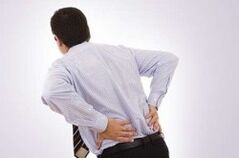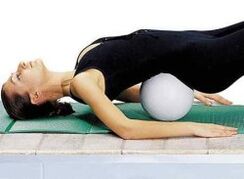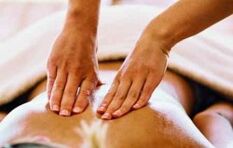With osteochondrosis of the spine, the bones and cartilage tissue of one or more spine is destroyed.This disease is chronic and develops in almost all elderly people.This is due to the usual aging of the body.

The intervertebral discs are subjected to atrophic changes and at what age this will happen depends on many factors:
- Injuries;
- Diseases and overload of the spine.
Spinal Overload belongs to:
- Walking with a curved back;
- incorrect place;
- Characteristics of the structure of the spine;
- Insufficient nutrition of the tissues of the spine due to hereditary abnormalities.
With osteochondrosis, the nucleus located between the vertebrate animals loses some of the water.Therefore, metabolic disorders are impaired in the nucleus and various minerals and vitamins are difficult to access.
After a while, cracks appear in the disc, it becomes flat.Then the nearby joints and connections begin to influence, forming inflammation of the tissues.Due to inflammation, there is a displacement of the adjacent vertebrae.This is dangerous for the onset of radicular symptoms: pain in the affected nerve.
The appearance of intervertebral hernia is also possible and in turn can cause compression of the spinal cord.Osteochondrosis is characterized by the appearance of osteophytes - bone growth on the vertebrae bodies.These outgrowths can pull out the spinal cord and cause Rooser syndrome.
Most often the cervical and lumbar parts are subject to osteochondrosis.
Cervical osteochondrosis
Reasons:
- sports activities (heavy athletics);
- Excess weight;
- metabolic disorder;
- Study work (programmers, accountants, drivers, etc.);
- flat legs;
- spinal injuries;
- Hypothermia.
Symptoms
The main symptoms of osteochondrosis of the cervical spine are pain in the head and neck.The person is concerned about severe headache, neck pain, giving in the hand, pain in the sternum.The patient may complain about shelters - the appearance of acute neck pain, spasm of muscle muscle and restriction of movement.
Also, one can hear a crunch when they turn the neck.Due to the pinching of the nerves and blood vessels, one may have tingling of the tongue and tips of the top.The patient will complain of hearing and vision reduction, high blood pressure and weakness in the muscles of the hands and feet.
Thoracic osteochondrosis
This type of osteochondrosis is quite rare.This is due to the anatomical structure of the chest spine.It consists of 12 vertebrae that are connected to the ribs due to the joints.Before the ribs are connected to the sternum.This creates an excellent frame of the spine, sternum and ribs, which protects the internal organs from various injuries.
The vertebrae of the thoracic region have low height and long spicy processes that are located above the other like a tile.Because of this structure, this spine is a small mobility.The intervertebral discs of the thoracic area are rarely injured.
The causes of this type of osteochondrosis:
- irrational load distribution;
- slowing the diet of intervertebral discs;
- Study work;
- The presence of scoliosis.
Symptoms
As with other species, the leading symptom of chest osteochondrosis is pain.
But with thoracic osteochondrosis, the pain may be different.Dorsalgia - long discomfort and poor pain along the thoracic vertebrae.Pain can affect the cervical and lumbar areas.
Dorsago is one of the signs of osteochondrosis of the thoracic region, in which pain occurs in the form of an attack.By nature, it is intense, acute, leading to difficulty breathing, leading to limitation of muscle movements.In addition to the pain, patients may have a feeling of tingling in the chest, impaired sexual function, heart pain, kidneys and stomach.
Why are damage to the thoracic region dangerous?
The peak column is arranged in such a way that it narrows in the thoracic area so that the hernia that occurs due to osteochondrosis will quickly lead to compression of the spinal cord.This will easily lead to problems from the heart, pancreas, liver and kidneys, since the thoracic area is associated with all these organs of nerve fibers.That is why it is very important to consult a doctor on time.This will help to understand where the signs of osteochondrosis that bother you come and will have a competent treatment for the disease.
Lumbar osteochondrosis
Osteochondrosis of the lumbar spine occurs due to the severity of lifting.Usually in the center of the intervertebral disc is a nucleus containing a large amount of water.Due to the liquid, the nucleus becomes a little compressed and 500 kg will be compressed to break it.
However, the disc, hit by osteochondrosis, becomes more glorious and will only need 200 kg to break it.If a person weighing 70 kg lifts 15 kg of loads in a bent position, and for the spine it is a load of 200 kg, the intervertebral disc can burst.Therefore, the first symptoms of osteochondrosis of the spine are manifested when the severity is lifted.
Symptoms
- lumbar pain;
- the inability to move in the lower back;
- disturbed sleep;
- irritability;
- fatigue;
- the inability to grow household needs;
- reducing sexual function in men;
- Menstrual cycle disorder;
- Cold leg syndrome.
In the transition of osteochondrosis to the sacral region, the patient has kidney pain and urination.
Diagnostics
The treatment of osteochondrosis is performed by a neurologist.Initially, he examines the spinal column, paying attention to the presence of scoliosis.Once he feels, the doctor will be able to understand how amazed the spine, tendons and nerves.
Once the neurologist will suspect osteochondrosis of the spine, he or she will direct the patient for further examination.This includes the passage of X-ray examination, magnet resonance.In case of suspicion of the destruction of the intervertebral disc, a discography is performed.It is also prescribed to determine the degree of nerve damage.
In general, the diagnosis of "osteochondrosis of the spine" is very difficult.After all, one can complain of heart pain, liver, kidneys, pancreas or sexual dysfunction.However, with a careful examination, an experienced doctor will be able to suspect this disease and prescribe proper treatment.
Treatment
Osteochondrosis therapy is a very long and difficult process.In the acute period, the patient needs the peace of the affected segment.If the cervical department is affected, then the patient should wear a fixing collar of the goofy.If the lumbar region hurts, the patient needs bed rest.It is best to place the patient in a hospital.Only there will he be able to monitor the completely defined regime.Such a patient's bed should be difficult.To do this, put a wooden shield under the mattress.
Medication
As mentioned above, the main symptom of the disease is pain.Therefore, the patient is prescribed analgesics to relieve pain and other symptoms of osteochondrosis.
Non -steroidal anti -inflammatory drugs are also prescribed.
Unfortunately, the prolonged use of these drugs causes damage to the gastrointestinal mucosa and the patient has the following symptoms:
- nausea;
- vomiting;
- stomach pain;
- Feeling in the stomach.
Gastric ulcer can also be exacerbated or gastric bleeding may occur.Therefore, you should consult a doctor before using these medicines.If the pain caused by osteochondrosis lasts for 3 months, antidepressants are prescribed with these drugs.In addition to the calming effect, they are found to be able to reduce pain.
All of the above medicines may be due to symptomatic therapy.They will help relieve pain, but they will not save a person from the disease itself.
In order to restore the intervertebral discs and cartilage, chondroprotectors are prescribed.These drugs improve metabolism in connective tissue and contribute to the repair of cartilage.Medicines take a long period of time, on average - 4 - 6 months.
In addition to the repair of tissues and improving their metabolism in them, these drugs also have an analgesic effect.Another group of medicines needed for osteochondrosis of the spine is medicines that improve blood circulation.Their use contributes to the enlargement of blood vessels and if antioxidant preparations are taken in combination with them, then the metabolism of nerve cells will improve in humans.
As with any disease, patients need calcium preparations.It will restore bone tissue activity, increase the strength of the ligaments and tendons, and will also become the prevention of osteoporosis, a disease that accompanies osteochondrosis.

Medical physical education
Dosage load on the spine will improve the patient's condition.But you need to perform exercise extremely carefully.In the acute period, physical education classes are contraindicated.Only with the lower pain can it start to deal with a little.
Exercise will improve blood circulation in the spine, will strengthen the muscles.Due to blood flow, metabolism will improve and the recovery of damaged intervertebral discs will begin.But we should also remember that the classes should be held regularly, otherwise there will be no result.
Exercises to damage the cervical region
- Lie on your back and stand up.Put one hand on your stomach and the second on your chest and take a breath, raise breath for 10 minutes, then exhale and relax.The duration of the exercise is 3 - 5 minutes.You should perform 3-5 times a day.
- Lie on your stomach and straighten your feet.Based on the stomach and legs, you should lift the head and upper chest.Exercise do 3 - 5 minutes with an interval of 30 seconds.
- Lie on your back and bend your knees.In this position, turn right and left side.Exercise do 3 - 5 minutes with an interval of 30 seconds.
Exercises to damage the chest region
- Lie on your stomach.Place your hands on the floor and bend back.Hold in this position for 5 -10 seconds.Exercise did 3 - 5 minutes with an interval of 20 seconds.
- Lie on your back.Lift your head and legs up ("boat").It lies in 10-20 seconds.Exercise did 3 - 5 minutes with an interval of 20 seconds.
Exercises to damage lumbar
- Lie on your back, bend your knees and press them to your chest.Sweetese back -back and roll from the back to the sacrum and back.Sweat up to 2 minutes.Then you have to go to bed and relax.
- You need to stand on fours and bend as much as possible.Exercise did 3 - 5 minutes with an interval of 20 seconds.
- In the upright position, imagine twisting the hoop for 2 - 3 minutes.Exercise performs 10 times a day.
Surgical treatment
In the absence of the effect of conservative treatment and the onset of complications of osteochondrosis, surgical treatment is prescribed.During surgery, stabilization of the spine is performed, the pressure on the spinal cord and the roots are eliminated.If a person has intervertebral hernia, it is removed.As this surgery may damage the spinal cord and nerves, it is performed only according to vital indications.
Physiotherapy
The appointment of physiotherapy procedures has a positive effect on the course of the disease and speeds up the recovery process.With osteochondrosis is allowed:

- Visit to a sauna or bath;
- swimming in the pool;
- massage;
- paraffin therapy;
- Manual therapy;
- laser therapy;
- different bathrooms;
- mud;
- electrophoresis with anti -inflammatory drugs or muscle relaxants;
- magnetotherapy;
- D 'Arsonval.
All these procedures improve blood circulation in the diseased area, allow you to relax to the muscles and relax the whole body.Physiotherapy procedures are prescribed during the rehabilitation period when the patient is not disturbed by severe pain.
Prevention
No one is safe from osteochondrosis.After all, we all grow old and with us our whole body is getting old.In order for the disease to not destroy your plans, you still need to exercise from youth.Moderate physical activity helps to improve blood circulation, normal metabolism.He also trains muscles that protect the spine.To prevent osteochondrosis everyone should:
- Feeding properly - the vitamins and minerals needed for the body;
- abandon bad habits;
- participate in physical education;
- Do not bend down;
- protect your back from hypothermia;
- Do not grow too heavy objects;
- Take a contrast shower and harden;
- Avoid stress.
It is especially important that people suffering from this disease follow all the recommendations, as their failure to comply with exacerbation.When a back pain that does not go away for a long time, you need to seek help from a specialist.Only a doctor will be able to make the right diagnosis and prescribe treatment.
Do not tighten yourself with a visit to the clinic because it is better to treat the disease in the early stages.Also, do not self -assess - each medicine has its own contraindications that you may not know about.Strictly observe all the doctor's recommendations and then the disease will soon withdraw!






















